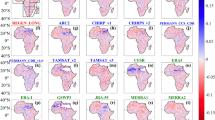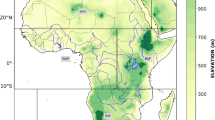Abstract
Applying combined nonlinear indices is a useful approach in assessing drought condition. This study investigates a combined multivariate index (Joint Deficit Hydro-meteorological Index: JDHMI) in monitoring hydro-meteorological drought to determine whether the index could simultaneously reflect the complicated nonlinear behavior of precipitation and runoff in a watershed. The JDMI (JDHI) index is obtained on the basis of the joint marginal distribution of SPImod1,…, SPImod12 (SRImod1,…, SRImod12) using the empirical copula. The JDHMI then is computed by combining the JDMI and JDHI indices using a suitable theoretical copula. Furthermore, drought characteristics (severity-duration-magnitude) are extracted from the JDHMI and trivariate conditional return periods that are obtained from three-dimensional copulas in four different scenarios. Results of this study indicate that (1) multivariate copulas effectively reflect the complicated and nonlinear relationship between drought variables; (2) comparison between univariate and multivariate drought indices indicated that the JDHMI is slightly more sensitive to the historical events; and (3) spatial distribution of drought hazard is illustrated using conditional return period obtained in four different scenarios in Bandar-Sedij and Kole-Mehran watershed. Additionally, the conditional probabilities provide effective information for forecasting drought conditions. In this regards, on the basis of several specific values of S-D-M, it is estimated that the central and eastern parts of the region will experience frequent hydro-meteorological drought over next 18 years. Finally, due to the climatic changing in the recent years, findings of this study could be useful in reducing drought effects on the natural resources and also help decision-makers in developing water resources.











Similar content being viewed by others
References
Bazrafshan O, Mahmudzadeh F, Bazrafshan J (2017) Evaluation of temporal trends of the drought indices SPI and SPEI in the Southern Coast of Iran. Desert Management 4(8):54–69
Bazrafshan O, Zamani H, Shekari M (2019) A copula-based index for drought analysis in arid and semi-arid regions of Iran. Nat Resour Model 33:e12237
Bazrafshan, O., Zamani, H., Shekari, M., & Singh, V. P. (2020). Regional risk analysis and derivation of copula-based drought for severity-duration curve in arid and semi-arid regions. Theor Appl Climatol, 1-17
Borji M, Malekian A, Salajegheh A, Ghadimi M (2016) Multi-time-scale analysis of hydrological drought forecasting using support vector regression (SVR) and artificial neural networks (ANN). Arab J Geosci 9(19):725
Byun HR, Wilhite DA (1999) Objective quantification of drought severity and duration. J Clim 12(9):2747–2759
Chen, X., Li, F. W., Li, J. Z., & Feng, P. (2019). Three-dimensional identification of hydrological drought and multivariate drought risk probability assessment in the Luanhe River basin, China. Theor Appl Climatol, 1-22
Choubin B, Khalighi-Sigaroodi S, Malekian A, Ahmad S, Attarod P (2014) Drought forecasting in a semi-arid watershed using climate signals: a neuro-fuzzy modeling approach. J Mt Sci 11(6):1593–1605
Choubin B, Malekian A, Golshan M (2016) Application of several data-driven techniques to predict a standardized precipitation index. Atmósfera 29(2):121–128
Cohen J (1968) Weighted kappa: nominal scale agreement provision for scaled disagreement or partial credit. Psychol Bull 70(4):213–220
Dracup JA, Lee KS, Paulson EG Jr (1980) On the statistical characteristics of drought events. Water Resour Res 16(2):289–296
Eghtedar Nezhad M, Bazrafshan O, Bazrafshan J (2018) Spatio-temporal variations of meteorological drought using standardized precipitation evapotranspiration index in Iran. J Agric Meteorol 5(2):35–46
Eslamian S (ed) (2014) Handbook of engineering hydrology: modeling, climate change, and variability. CRC Press, London
Farid R. 2006. Bivariate frequency analysis of regional drought characteristics Ph.D. thesis, University of Waterloo. Canada
Genest C, Rivest LP (1993) Statistical inference procedures for bivariate Archimedean copulas. J Am Stat Assoc 88(423):1034–1043
Genest C, Rémillard B, Beaudoin D (2009) Goodness-of-fit tests for copulas: a review and a power study. Insurance: Mathematics and economics 44(2):199–213
Hao Z, AghaKouchak A (2013) Multivariate standardized drought index: a parametric multi-index model. Adv Water Resour 57:12–18
Hao Z, Singh VP (2012) Entropy‐copula method for single‐site monthly streamflow simulation. Water Resour Res 48(6)
Hao Z, Singh VP (2015) Drought characterization from a multivariate perspective: a review. J Hydrol 527:668–678
Hofert M, Mächler M (2011) Nested Archimedean copulas meet R: the nacopula package. J Stat Softw 39(9):1–20
Hui-Mean F, Yusof F, Yusop Z, Suhaila J (2019) Trivariate copula in drought analysis: a case study in peninsular Malaysia. Theor Appl Climatol:1–15
Kao SC, Govindaraju RS (2010a) A copulabased joint deficit index for droughts. J Hydrol 380:121–134
Kao SC, Govindaraju RS (2010b) Reply to comment by TP Hutchinson on “Trivariate statistical analysis of extreme rainfall events via the Plackett family of copulas”. Water Resour Res 46(4)
Kazemzadeh M, Malekian A (2016) Spatial characteristics and temporal trends of meteorological and hydrological droughts in northwestern Iran. Nat Hazards 80(1):191–210
Liu Y, Zhu Y, Ren L, Yong B, Singh VP, Yuan F, Jiang S, Yang X (2019) On the mechanisms of two composite methods for construction of multivariate drought indices. Sci Total Environ 647:981–991
McKee TE (2003) Rough sets bankruptcy prediction models versus auditor signalling rates. J Forecast 22(8):569–586
McKee, T. B., Doesken, N. J., & Kleist, J. (1993). The relationship of drought frequency and duration to time scales. In Proceedings of the 8th Conference on Applied Climatology, 17(22), 179–184
Mirabbasi R, Anagnostou EN, Fakheri-Fard A, Dinpashoh Y, Eslamian S (2013) Analysis of meteorological drought in Northwest Iran using the Joint Deficit Index. J Hydrol 492:35–48
Mishra AK, Singh VP (2010) A review of drought concepts. J Hydrol 391:202–216
Moradi M, Bazrafshan O, Bahreman A, Esmaelpour Y (2018) Assessment of the relations between the trends of climatic factors and river flow in southern coastal watersheds, Iran. Watershed Management Researches Journal 31(2):79–92
Nalbantis I, Tsakiris G (2009) Assessment of hydrological drought revisited. Water Resour Manag 23(5):881–897
Naresh Kumar M, Murthy CS, Sesha Sai MVR, Roy PS (2009) On the use of standardized precipitation index (SPI) for drought intensity assessment. Meteorological Applications 16(3):381–389
Nasrollahi M, Khosravi H, Moghaddamnia A, Malekian A, Shahid S (2018) Assessment of drought risk index using drought hazard and vulnerability indices. Arab J Geosci 11(20):606
Nelsen RB (2006) An introduction to copulas. Springer, New York, 269 pp
Obasi GOP (1994) WMO’s role in the international decade for natural disaster reduction. Bull Am Meteorol Soc 75(9):1655–1661
Quiring SM (2009) Developing objective operational definitions for monitoring drought. J Appl Meteorol Climatol 48(6):1217–1229
Salvadori G, De Michele C (2004) Frequency analysis via copulas: theoretical aspects and applications to hydrological events. Water Resour Res 40(12)
Saravi MM, Safdari AA, Malekian A (2009) Intensity-duration-frequency and spatial analysis of droughts using the Standardized Precipitation Index. Hydrology & Earth System Sciences Discussions 6(2)
Shiau JT (2006) Fitting drought duration and severity with two-dimensional copulas. Water Resour Manag 20(5):795–815
Shukla S, Wood AW (2008) Use of a standardized runoff index for characterizing hydrologic drought. Geophys Res Lett 35:L02405
Sklar A (1959) Distribution functions of n dimensions and margins, vol 8. Publications of the Institute of Statistics of the University of Paris, Paris, pp 229–231
Trinh T, Ishida K, Kavvas ML, Ercan A, Carr K (2017) Assessment of 21st century drought conditions at Shasta dam based on dynamically projected water supply conditions by a regional climate model coupled with a physically-based hydrology model. Science Total Environ 586:197–205
Wilhite DA, Svoboda MD, Hayes MJ (2006) Understanding the complex impacts of drought: a key to enhancing drought mitigation and preparedness. Water Resour Manag 21:763–774
Wong G, Lambert MF, Metcalfe AV (2008) Trivariate copulas for characterization of droughts. Anziam J 49:306–323
Yang J, Chang J, Wang Y, Li Y, Hu H, Chen Y, Huang Q, Yao J (2018) Comprehensive drought characteristics analysis based on a nonlinear multivariate drought index. J Hydrol 557:651–667
Zamani H, Bazrafshan O (2020) Modeling monthly rainfall data using zero-adjusted models in the semi-arid, arid and extra-arid regions. Meteorog Atmos Phys 132(2):239–253
Zargar A, Sadiq R, Naser B, Khan FI (2011) A review of drought indices. Environ. Rev. 19(NA):333–349
Acknowledgements
The authors truly appreciate the Research Deputy, University of Hormozgan for their collaboration and I.R Iran Meteorological Organization (IRIMO) for related data.
Author information
Authors and Affiliations
Corresponding authors
Additional information
Publisher’s note
Springer Nature remains neutral with regard to jurisdictional claims in published maps and institutional affiliations.
Rights and permissions
About this article
Cite this article
Azhdari, Z., Bazrafshan, O., Shekari, M. et al. Three-dimensional risk analysis of hydro-meteorological drought using multivariate nonlinear index. Theor Appl Climatol 142, 1311–1327 (2020). https://doi.org/10.1007/s00704-020-03365-3
Received:
Accepted:
Published:
Issue Date:
DOI: https://doi.org/10.1007/s00704-020-03365-3




